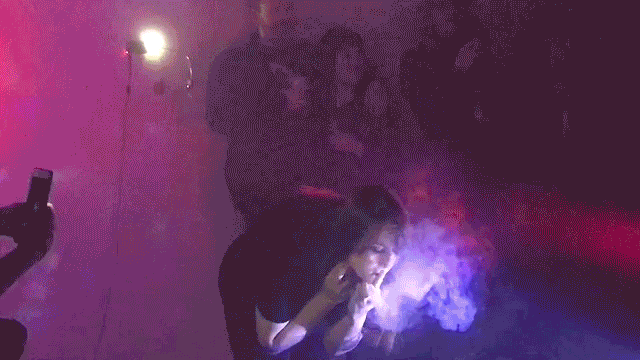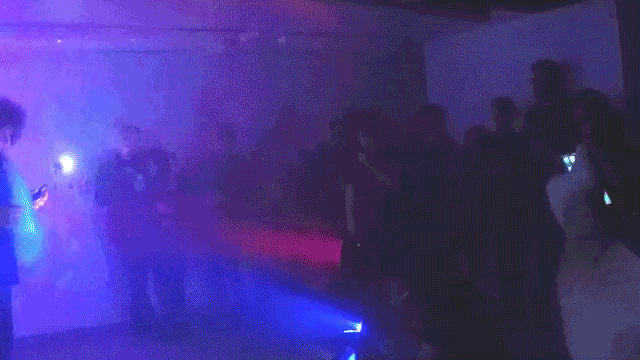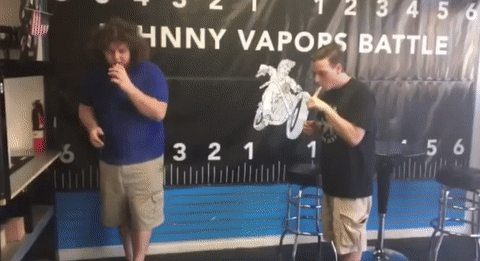a solo exhibition by Chris Meerdo
March 4th – April 2nd, 2017
exhibition reception March 4th, 6pm / choreographed vape performance at 9pm
open by appointment through April 2nd, 2017
@ Coco Hunday, 212 W Thomas St, Tampa, FL 33604

A Conversation with Kristi McGuire & Christopher Meerdo
Kristi McGuire: I’m starting with the vape performance, even though you more-or-less told me not to worry about the vape performance because it’s an ephemeral installation that presently only exists in your mind, until you outsource the labor. But I think maybe there’s something about choreographing the vape—vaping, like smoking cigarettes c. 1999, is a form of social architecture—in this sense, it’s less a performance and more a cornice, a decorative motif (performance, I’d argue, borrowing from Peggy Phelan, only exists at the moment you try to document it and then poof; “vape” is literally from the inside, the Latin for “body heat,” always with you, even if you only inhale every now and again). It’s pretty Rococo, as consumerist adornments go. What’s making you want to collaborate with the synchronized vapors/vapers? Is it because the device locates us in a diffuse kind of capitalism—one based on the fact that technology is now almost too emptied out of meaning to do anything particular with, short of lighting it on fire and looking for smoke signals?

Christopher Meerdo: I am really interested in your notion of social architecture with this piece. I have been imagining the performance along a hierarchical mode of organization occupying nesting spheres: the performers syncing with each other in front of a live audience; the members of the performance, who also belong to an articulated and nuanced vape subculture, which exists and emerges IRL via the web; and lastly, locating the performance as embedded in the larger sphere of national citizenship relative to the geopolitical presence of American-Russian bilateralism. The latter is expressed within the performance via an audio recording of the synchronized swim routine executed by Russia’s “angels” at the 2016 games in Rio. Here, I’m referring to the vape community and other net subcultural modalities as critical linguistic and ideological nuclei, and I’m pointing to recent reenactments of subversive Cold War-era double entendres and euphemisms within these spaces (functioning in what I see as an updated proxy war). There is a holistic and technologically transcendent quality to the vape community and I am curious about how it can function in antithetical and perhaps resistant ways, as compared to hard-edged, alt-right online movements, despite emerging from similar internet zones.
I am also interested how vaping moves from a hacking community online to a physical space (vape shops, meetups, and competitions) and then ends in an ephemeral distillation of the body—through a kind of metaphysic of smoke—literally pushing an embodied dimension out into a space. I am both referencing the presence of this techno-spiritual dimension/analogous structure in vaping and the promise of transcendence/liberation/comfort/tranquility, etc. within consumer culture (and neoliberal technological innovation) in the show’s title, Sub-Ohm. By vape definition, Sub-Ohm is a type of advanced vape construction that requires a high degree of electronic knowledge to achieve and results in mega-vape cloud capabilities in the vape devices. I was also thinking about the traditional meditative mantra om, considered to be “the sound of existence.” Sub- also has its own connotations within BDSM communities that play well here, too—specifically if we think about the voluntary or involuntary subordinate positions that capitalism produces relative to technology: NSA/Prism data and metadata caches, the validity of voting mechanisms, or net neutrality.
Lastly, going back to this idea of techno-spiritual analogs, we should get into not just the metaphysics of bodies, but objects, as well. I have been really excitedly reading about animism and how it could be a corollary to the Internet of Things. The basic principle of animism—the attribution of a soul or spiritual dimension to inanimate objects—acts as an organizing structure. The IoT has a strange relationship with Cartesian dualism and complicates my (and assumedly many others’) hard materialist worldviews.

KM: I get the animism thing. Oh, god, I really love the RPI sculpture with the Himalayan salt crystal lamp; I see myself in it. Or rather, I see the absurdity of the New Age-y ness of the IoT. Unlike the lamp, I don’t buy the notion that my iPhone is purging ions from the atmosphere, but I also don’t always think about the air conditions around Congolese workers mining Coltan while I’m using Signal to frag my text messages. That’s where the animism comes in for me. C-O-M-M-O-D-I-T-Y F-E-T-I-S-H-I-S-M. The IoT simultaneously activates and makes complicit so many political “trends”: mass consumption and horizontal marketing, the fiscalization of the individual above all else, technocracy, the surveillance state, globalization and a lack of workplace regulation. Neoliberalism remaking everything and everyone in the image of homo oeconomicus is late capitalism’s religious order for me, but I feel like the blasé, devil-may-care aesthetic you incorporate in these sculptures is pointing toward the absurdity of this worship, while mirroring the hands-off approach of laissez-faire economics—“if you build it, they will [buy it]” style?
CM: Yeah, I like your read here, and I agree—the salt crystal is an important moment within this series where the false promise of the IoT through a neoliberal economic lens becomes a farce. We project so much hope and glorified redemption into gadgetry that it’s quite poignant. Sodastream, Google Glass (RIP), fidget spinners, mouth exercisers, smartphones, Fitbit, essential oil lamps. There is the all-too-familiar life enhancement via consumption that I enjoy and abhor simultaneously.
KM: Office toys. Yeah, so I think I mentioned this: I talked a bit about stress balls in my Cranbrook lecture—I got there because I’m pretty interested in the privatization of stress, which is a succinct way of stating that one of the manners in which I think capitalism monetizes our alienation is through this weird axis where self-care meets [capital-c, capital-i] Corporate Interest. The guy who invented the modern stress ball—Alex Carswell, in 1988—did so in the wake of an angry phone conversation with an ex-boss that ended in Carswell throwing his pen at a picture on his desk, knocking it over and shattering the glass everywhere. Novelty items and office toys are actually f-cked-up totems of abstract labor, but they’re funny. Probably because kitsch is our only authentic vernacular of social class these days (because it’s not authentic at all, and doesn’t aspire to be so). Your work is funny; the Raspberry Pi sculptures have a late 1980s mini-fan meets the hologram kind of base-level humor to them, not to mention references to lol culture and IoT-speak. Do you think you deliberately inject humor into these sculptures because the truth of it all is pretty bleak? Or are we passing through our IoT phase as ASCII shruggies, with some kind of perverse optimism? You can read the claims that trademarked the Koosh ball at Google Patents, btw.

^performance documentation / Coco Hunday / @zebratricks @wldthng @ellavapes
CM: You don’t know how much time I spent in Spencer’s Gifts as a kid in the ’90’s. But in all honesty, the humor in the work is a kind of “smiling but dead inside” approach to my preoccupation with the IoT. I originally created the first Pi sculpture for an exhibition with a 420 theme and wanted to make a custom PC (with all the black light and LED accoutrements) that would also double as a weed smoking device. Given time and budgetary constraints, I opted for a shorthand version: a Raspberry Pi microcomputer with a Snoop Dogg “G-Pen” vaporizer charging in the USB port. I appreciate the doubling that is produced (like your stress-ball example) when our coping mechanisms for life under hyper-capitalism also become monetized in a way that fortifies that same system. The grandson of a metallurgist who worked on the development of the first atomic bomb invented the mechanism for blowing the giant bubble. Talk about trauma being expressed through novelty. . . .
KM: I was pretty into the robot fail moments in Werner Herzog’s Lo & Behold—there’s something about the juxtaposition of that cultivated naiveté in his voice that lends gravitas, which just makes the narrative all the more absurd, at times. But I think my question here is pretty blunt: are we preoccupied with robot fails because they end up a metaphor for the deregulation and dematerialization of labor in neoliberal capitalism (let’s see if I can make it through a question without mentioning capitalism)? I’m thinking about other historical instances of this: Johnny 5 from Short Circuit, released the same year as the apogee of the Savings and Loan Crisis; Charlie Chaplin’s automatic feeding machine in Modern Times during peak Fordism; Lucy and Ethel and the candy factory assembly line as anticipating that Fordism falling apart (also the 1980s TV show Small Wonder—there’s a point in the mid-’80s during the union-busting deregulation of industry when popular culture is obsessed with human-robot hybrid forms—i.e., Inspector Gadget is an infantile version of Robocop, which introduces the cyborg police state, albeit in its most bumbling form).
CM: This is such an accurate read—I suppose we can talk about another type of synchronization here as well moving outward from the IoT. Your question makes me think about one of my favorite Virilio ideas: with each new invention comes a new kind of catastrophe. Up to the Industrial Revolution—and perhaps through the Internet Age—we see these catastrophes playing out large-scale on a global stage. The framework of the IoT (and networks in general) transforms the discrete and monumental catastrophe that is the Industrial Era to quotidian and miniature forms. The scaling of the IoT can be included in other condensed frameworks: viruses (virtual and corporeal), nanotechnology, CRISPR, microcomputing, smart dust, visioning and listening devices. The calibration is shrinking dramatically and the ramifications of our catastrophes are all the more ubiquitous, omnipresent, and insidious as a result. And, as with the implications of these systems: omnipresence/omniscience/omnipotence and the promise of resurrection, colliding with the threat of annihilation, is a familiar God.
KM: What’s up with the repetition of the sculptures? How do you decide how many is the right amount? What’s serial about them, for you? This, coupled with the naming constraints you adopted, made me think about accumulating sh-t as a means of producing our humanity, with brand loyalty mixed in: I sort of exist if I own an iPhone, but I really f-cking exist if I own an iPhone and Mac laptop and iPad and my music comes from iTunes, because then when everything is synced up, my personhood comes from the pure performance of its infrastructure. I feel like your personal brand loyalty is attached to the ways in which the IoT is so embedded in our day-to-day that we don’t realize we’re the ones complicit in the monstrous growth of the surveillance state because our Fitbits (note: my Mac autocorrected “Fit Bit,” so everything is related) come in four colors and if you live in Manhattan, Amazon will ship one to you in an hour or less. What’s the loyalty of your practice?
CM: I don’t want to stop until I run out of novelty USB peripherals! It has become a challenge to me to see how far into the web I can shop. I have also been thinking about notions of consuming vs. hoarding that run a fine line. There is something deeply satisfying about receiving a present in the mail that you forgot about that you then get to open. I think this translates well when you look at the series as a whole—there is a certain leveling of meaning across all of the different devices and the capacity of each individual component loses itself to a larger sense of uselessness and e-waste. It’s really easy to tie this project to an earlier project of mine, Anthology, where I shopped on eBay for used camera memory cards for around five years. For that project, I was effectively recovering deleted photographs off of the cards using an e-commerce model as a rich archive to data mine. In this current project, e-commerce returns, but much more directly, and engages in conversation with the quantity of art in the world that comes directly from Amazon and Home Depot.

^performance documentation / Coco Hunday / @zebratricks @wldthng @ellavapes
KM: Give me your definition of the Internet of Things (IoT) in a single sentence. The IoT makes me feel ______________ because _________________ and that’s really ______________________.
CM: The Internet of Things makes me feel as though radical transhumanism cannot and will not exist without neoliberal economic forces propelling it into the hands of early adopters (read: the wealthy). And that’s really exciting and unfortunate all at the same time.
KM: There are 50,000 questions about the surveillance state and our data and the relationship of the understructures we engender through the IoT to some really dark sh-t that devolves into questions of human sovereignty; the limits to policing pursued by the nation state; the future of transnational telecommunications firms as our new overlords (who already own the satellites and data cables, without which, the world would not run); and the fact that algorithms, for all their mathiness, are a perverse manifestation of qualitative discrimination. What do you think the most pressing issue surrounding our data is? Who owns it, who wants it, and why?
CM: I keep going back to the cheating that was made explicit with the doping scandal surrounding the Russian Olympic teams and the interference in the Trump/Clinton presidential election. I am not totally sold on the strict idea that athletes shouldn’t dope—to be honest. When I think about queer and transgender theory as it relates to the body, the human biological form becomes a site of transformation, enhancement, imagination, expression, and even utopia. These aims are not unlike our already rampant technological transhumanism, which has many overlapping desires. Technology cures deafness, provides regulatory devices that control insulin levels or heartbeats, and provides neuro-prosthetics to amputees, but also gives us external memory and ocular contact lens cameras. So, I’m not sure the Russians cheated in the Olympics—by Olympic standards, yes, but by transhumanist definitions: no. Trump is a pure despicable troll, but I wonder if the particular kind of American election meddling the Russians engaged in could be re-imagined in a similar way—cheating is relative; boundaries are, in fact, reflexive and permeable constructs that are meant to be toppled, even if we dislike the ideology associated with it. That is the major tenant of hacking—taking apart a system to expand it, modify it, f-ck with it. Coming back to your question about big data: I want to believe the same thing: that we, as individuals, might have the power to reimagine, parody, dislodge, and queer those systems too; the NSA is only built on soil and network cables after all. ✂︎
Chris Meerdo Bio:
Christopher Meerdo is a Chicago-based artist who grew up in the Upper Peninsula of Michigan and Lithuania. He is the Fellowship 15 International Award winner for his projects Iceland and Cataphote, was an artist in residence at the SIM Program in Reykjavik, Iceland, 8550 Ohio, and attended the Skowhegan School of Painting and Sculpture in 2013. Meerdo received his MFA in Photography from the University of Illinois at Chicago in 2011. He currently teaches at the School of the Art Institute of Chicago. Recent solo exhibitions include The Mattress Factory Museum of Contemporary Art, Pittsburgh; DOCUMENT, Chicago; Exgirlfriend, Berlin; Coco Hunday, Tampa; The Hills, Chicago; and ITP Space, Jackson, WY. Recent screenings include Flat Earth Film Festival, Seyðisfjörður, Iceland; DAD/NADA, Miami Beach; Paris London Hong Kong, Chicago; Cabinet Magazine, Brooklyn, NY; Public Fiction, LA; and The Nightingale, Chicago.
Kristi McGuire Bio:
Kristi McGuire teaches in the Department of Visual and Critical Studies at the School of the Art Institute of Chicago.
